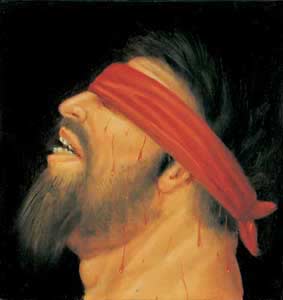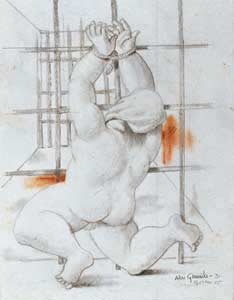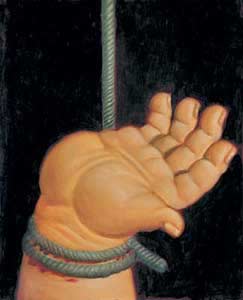Revolution #78, February 11, 2007
Revolution Interview
Fernando Botero and Abu Ghraib: “I could not stay silent”
The Revolution Interview is a special feature to acquaint our readers with the views of significant figures in art, theater, music, literature, science, sports and politics. The views expressed by those we interview are, of course, their own, and they are not responsible for the views expressed elsewhere in Revolution.
“Art is a permanent accusation”
—Fernando Botero
Fernando Botero is one of the world’s most well-known living painters and sculptors. On January 29, the exhibition “Botero: Abu Ghraib” opened at the University of California at Berkeley. Forty-three works, part of a collection of over 80 paintings depicting the torture in Abu Ghraib, are on display at the Doe Library until March 25. The exhibition is sponsored by the Center for Latin American Studies.
|
Stunning images of great power, the Botero paintings must be experienced. They are worth traveling to see. The prisoners’ huge bodies dominate the large yet claustrophobic canvases. They endure pain that is palpable to the viewer with a visceralness beyond the famous photographs, and this is horrifically compounded by a sick humiliating degradation of their culture and their very persons--yet these men convey a strength and a dignity that stays with you. While the torturers are rarely present in the works, several images chillingly portray the snarling, clawing, biting bloody attack dogs, capturing the mentality and ethos of those who unleashed them. The question is posed: what kind of society, what kind of country would visit such crimes against humanity? Spend some time in front of these huge canvases, or take time with the book or the images on line. Ask yourself, what am I doing to stop this?
|
This exhibition is the first time these works have been shown in a public institution in the United States. They were shown for one month last fall at Botero’s New York City dealer, Marlborough Gallery, but despite the fact that they’ve been offered to many museums across the United States over the past six months, not a single U.S. public institution had agreed to show these works until now.
The paintings have been shown in major museums in Italy, Greece, and Germany and have received enthusiastic reviews from critics, who have compared these paintings and drawings to works by Goya, Picasso, Siqueiros and Leon Golub.
When the Center for Latin American Studies at Berkeley heard that the paintings were being denied a public viewing in the U.S., they immediately sought to bring the works to Berkeley. The exhibition opened just two months and a day after the Center contacted Botero, an extremely short period of time to organize a major art exhibition.
|
“We are the first but we don’t intend to be the last institution in the U.S. to display these pictures,” said Harley Shaiken, a Berkeley professor and chair of the Center for Latin American Studies. Already, as a result of the Berkeley exhibition, the Katzen Arts Center at American University in Washington, DC has announced they will show the entire Abu Ghraib series later this year.
At the exhibition opening, over 500 people attended a conversation held between Botero and former U.S. Poet Laureate Robert Haas. Long lines began forming hours before the opening and more than 1,000 had to be turned away.
For many people with just a passing familiarity with the work of Botero, the hellish conditions at Abu Ghraib might seem to be an unlikely choice of subject matter. Botero is best known for his colorful doughboy-like figures–cherubic children, pampered pets, and musicians from his native Colombia.
Early in his career, commenting on criticism that his subjects appeared fat, Botero replied, “They look rather slim to me. My subject matter is sometimes satirical, but these ‘puffed-up’ personalities are being puffed to give them sensuality.… In art, as long as you have ideas and think, you are bound to deform nature. Art is deformation. There are no works of art that are truly realistic.”
|
Botero’s works can be deceptively simple and often combine humor, sensuality and innocence with biting social commentary. Over the years, he has created works that directly comment on the social and political conditions in Latin America. A 1971 work, Official Portrait of the Military Junta, was a satire of military regimes that presided over U.S. domination in Latin America. The bloated dictator and his obsequious followers (including a Catholic bishop) stand at stiff attention in full uniform, while flies buzzing around their heads give the sense of a regime “polished on the outside, but rotten at the core,” as one critic wrote. In the late 1990s, Botero produced a series of paintings that depict the horror of the drug cartel wars in Colombia.
Still, the Abu Ghraib series is a significant departure for Botero--he calls it “a parenthesis” in his career. Philip Kennicott wrote in the Washington Post, “[Botero’s] Abu Ghraib series feels more like a catalogue of dark memories, a compendium of outrages captured in a long-established people's vernacular, as a hedge against obfuscation and oblivion. These illustrations form a kind of history book, not one written by the victors but one sketched and colored by the meek of the earth, hidden away until the tables are turned and the truth can come out.”
|
Botero does not intend to sell any of the Abu Ghraib paintings. He says, “It is immoral to try and make money out of the suffering of the people.” He hopes to donate the series to an American museum that will put them in its permanent collection.
Revolution interviewed Fernando Botero at the January 29 opening of “Botero: Abu Ghraib.”
|
****
Revolution: How did you come to do this series of pictures on the torture at Abu Ghraib?
Fernando Botero: The whole world was shocked with the revelations in the American press of the American torture of the Iraqis in Abu Ghraib prison. I read this in the New Yorker in a famous article by Seymour Hersh. I was surprised, hurt, and angry, like everybody. The more I read, the more I was motivated and angry, upset. A few months later I was in a plane going back to Paris and reading again of this tragedy. I took paper and pencil and started doing some drawings. Then, when I got to my studio in Paris, I kept drawing and painting. It became like an obsession for 14 months. I was only working on this, thinking about this. And then, suddenly, I felt empty, like I didn’t have anything to say anymore. And I felt peaceful. For some reason I was at peace with myself. But for months I felt this desire to say something. Because I thought this was an enormous violation of human rights and the United States has been a model of compassion and a model of human rights and then they are doing something like this violation. It was the biggest damage ever to this country’s image. This morning I was talking to a journalist from Argentina and she was telling me that only 6% of the people in Argentina approve now of America and it was 70% three or four years ago. And this is happening all over the world. I’m surprised that more artists haven’t done something on this because it’s a big issue that cannot go away. It has to be remembered. I did like a testimony of this. Of course I know I’m not going to change anything; art doesn’t have that power. But at least I gave testimony of what happened. I could not stay silent. The power of art is to make you remember something and I hope that will happen with my work.
Revolution: What is the relationship between these paintings and the famous photographs of the torture at Abu Ghraib?
Fernando Botero: For me the photographs were very important to see the atmosphere where all this drama was going on. I saw the photographs, especially the dramatic lighting, because most of this torture was taking place in the night. I was inspired by the text. I tried to visualize what was going on. Painting has this ability to make visible what is invisible. There is no sense to copy a photo. I wanted to recreate the atmosphere in the prison with scenes that were not scenes in the photos, to make some idea of the feeling, so that I could communicate some idea of the horrors that were going on. A photo is a click. Of course it can be a tremendous document. But in painting there is this concentration of emotion through time, leaving out everything that doesn’t concern the subject, and this makes the images in painting have special meaning. In this case there is the photos and the text, but it was impossible in these to have the view of an artist. I don’t think it is the function of art to just recreate the images. Art has the capacity to make us remember a situation for a long time. When the newspapers stop talking, and the people stop talking the art is there. So many things that happened in history are known because of art. The paintings of Goya and [Picasso’s] Guernica, these things might be forgotten if not for their images. I hope that these paintings will serve as a testimony through time.
Revolution: How did spending so much time focusing on these images of torture and suffering affect you personally?
Fernando Botero: Of course it's more pleasant to do pleasant subject matters. All of my life, by conviction, I did subjects that were rather pleasant. Art history has been mostly of pleasant subjects. To take a small example you don’t see many sad impressionist paintings, and there were thousands of paintings. If you think of Botticelli or any of the great masters, they were mostly doing pleasant subject matter because the function of art was to give pleasure, to elevate man, and that was what they were doing. There is a beautiful definition of art given by Poussin, one of the greatest artists of the 17th century. He said painting is an expression in forms and colors on a flat surface to give pleasure. That was the idea of art at that time. They were doing things to give pleasure. Then, of course, there are painters who give pleasure through dramatic things. In dramatic art there is two elements, the aesthetics and the subject matter. One of the greatest artists of the past, Grünewald, a painter of 16th-century Germany, painted the most horrible scenes of the crucifixion. There could never be something more terrible. And you can have the pleasure of seeing the tremendous aesthetic beauty of these and in time you feel the pain.
In my case, I was, of course, having the pleasure of painting. The act of painting is something very pleasant. But the moment I started the first sketch, I felt angry. But when I started working, it is such a sensual thing to paint that you have pleasure, you cannot deny this. But from the first moment you have this angry feeling, you are upset, that this is not right; this is not possible.
This is a testimony. This is not anti-American, because then the New York Times is anti-American. If you present facts then it doesn’t mean that you are anti-American. These paintings are anti-inhumanity. You cannot stay silent when something like this goes on, and let only the politicians and the newspapers take care of it. The artist is also a human being and is concerned and reads the paper and has feelings. And our thing is to express ourselves. An artist expresses himself to communicate. If you hide this, then art doesn’t exist. Art exists in the minds of people. Otherwise the art is nothing, it’s just a piece of canvas. What it gives to the spectator, what stays in their mind, is what’s important. That’s why art has to be seen. In this case I want these paintings to give a moment of reflection and to stay in the mind of people. Because that’s the function of art, I believe.
*****
|
If you like this article, subscribe, donate to and sustain Revolution newspaper.









